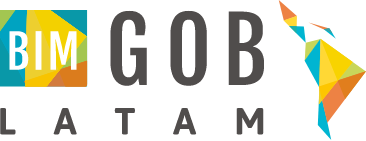

The BIM Network of Latin American Governments is an organization that brings together eight countries in the region. (Argentina, Brazil, Chile, Colombia, Costa Rica, Mexico, Peru and Uruguay) in a collaborative effort to accelerate national digital transformation processes, by targeting the implementation of Building Information Modelling (BIM) in the construction sector.
The Latam BIM network has the objective of increasing the productivity of the construction industry through digital transformation, accelerating national BIM implementation programs through collaborative work that favors and promotes common guidelines, commercial exchange and knowledge in the region.
Promoting learning about the implementation of BIM by members of the Network.
Spreading the benefits of BIM to achieve conviction of decision-makers.
Agreeing on a common conceptual basis that promotes regional alignment for the adoption or creation of BIM standards and protocols.
Boosting the use of tools that encourage transparency and traceability in public projects.
Maximizing resources through collaboration and knowledge transfer between countries.
Idea of forming the Network from Planbim Chile
Backup search.
1st Meeting – Chile
5 countries: Argentina, Brazil, Chile, Mexico and Uruguay.
2nd General Assembly – Brazil.
7 countries: 5 + Colombia + Costa Rica.
Allocation of IDB funds
3rd General Assembly – Uruguay
8 countries: 7 + Peru
4th General Assembly – Argentina
Start of IDB-BPR
Election of the first presidency: Chile
5th and 6th General Assembly (Virtual)
Beginning of the working groups
1st Open Seminar
Re-election Presidency: Chile
Web development
Studies and Startup Development Handbook
Analysis of the adoption of regulations at the regional level
Roadmap
7th and 8th General Assembly (Virtual)
2nd Open Seminar
Presidency Election: Colombia
Website Launch-Brand Development
Publication of map of analysis of adoption of standards at regional level
Development Handbook-Manual BIM Latam
Development of Standards Prioritization Guide
9th and 10th Semiannual Meeting (Virtual)
Presidency : Argentina
Consulting Launch: Training on BIM Topics to Network Members
Publication of Products:
-BIM Strategies of the Member Countries of the BIM Network of Latin American Governments.
Prioritization Guide for BIM-Related ISO Standards.
11th Semiannual Meeting – Face-to-face in London, United Kingdom.
Presidential Election : Peru
12th Semiannual Meeting – Virtual

The Network currently has support and co-financing from the Inter-American Development Bank (IDB). The member countries contribute resources in kind equivalent to 50% of the assigned amount, represented in personnel, equipment and institutional relations.
A Regional Public Good (BPR) was granted with a term of 3 (three) years. December 2019-December 2022.
In March 2022, the extension of the BPR is granted until December 2023.
The Network partners (countries) will work together to develop actions, common strategies and other content, generating Outputs that will serve as advisory, informative and dissemination support for the fulfillment of the Network’s objectives.
The governmental organizations that are part of this initiative are represented by government functionaries who are in charge of carrying out the implementation in their respective countries.
The Network is governed by a statute, whose objective is to regulate the scope, application, conformation and operation of the Latam BIM Network, for the achievement of the goals and objectives set out by that initiative.
This statute has been signed in November 2019, giving formal start to the Network and updated in November 2021.
Organizational structure:
BIM Manager Specialist of the Plan BIM Peru Team
Ministry of Economy and Finance (MEF)
The President is elected by the Board. The designation is for a one-year term and, in addition to the tasks of supervision and organization in order to achieve the technical, administrative and financial objectives, represents the Network and the Board in all aspects.
The governance of the network is regulated by the Board , which is ultimately responsible for the achievement of the objectives set by the Network.
It is integrated by representatives (titular-Adjunct and/or Substitute) from each member country.
The Board meets every month in order to verify the progress and/or pending issues of the network, according to the established planning.
The Coordination supports the Board and the presidency in the monitoring and annual management of the projects, the fulfillment of the network’s schedule and objectives, technical, administrative and communication tasks, as well as support to the Network’s working groups.
The working groups are formed with the purpose of developing the thematic areas prioritized by the Board.
Integrated by representatives and participants, who are officials from each country, led by a designated spokesperson.
The working groups meet bimonthly in order to move forward with the planned actions and Outputs

The country interested in joining the Network must have at least one public institution interested in the promotion of the BIM methodology by the National or Local Government.
Motivations to join the Network, indicating the category of membership you aspire to.
Level of progress of BIM in the public sector of the respective country, indicating what is the projection of BIM implementation at governmental level in the next five years, in the following aspects: Human Capital; Enabling Technologies; Standardization; and Governance/Institutionality.
Name and description of the representative government institutionthat will join the Network.
Names, positions and institutions to which the representatives belong – titular, adjunct and substitute, the last one if required.
It should also include presentations or documents referring to public policies on digital transformation in buildings and/or infrastructure in the applicant country.
The Board will ensure that there is only one official representation per country.
BIM BR Strategy, Ministry of Development, Industry, Commerce and Services (MDIC), Government of Brazil.
Planbim, Corporation for the Promotion of Production of the Ministry of Economy, Development and Tourism. Government of Chile.
BIM Interinstitutional Commission, Ministry of Public Education and Costa Rican Institute of Aqueducts and Sewers (AyA).